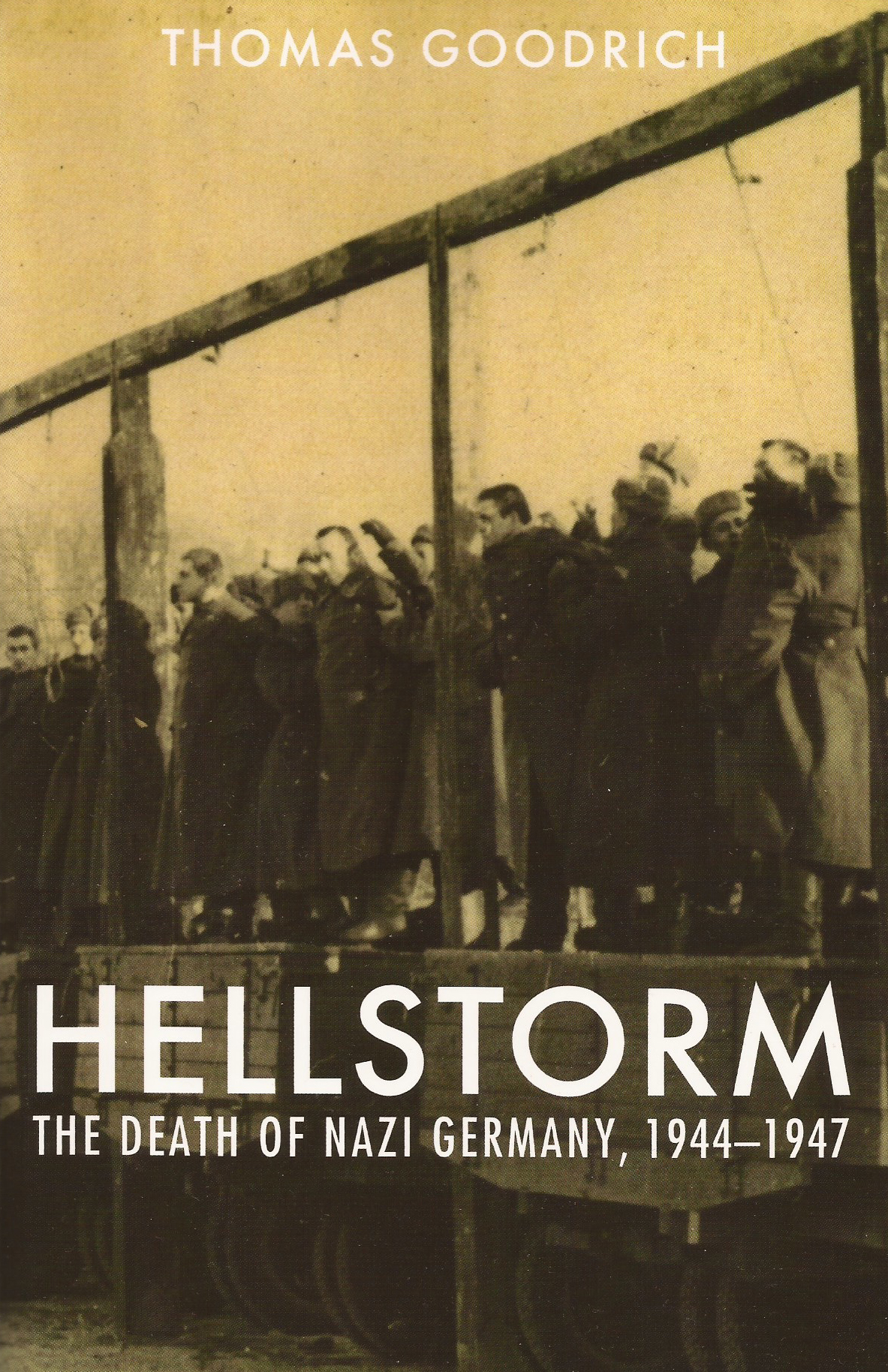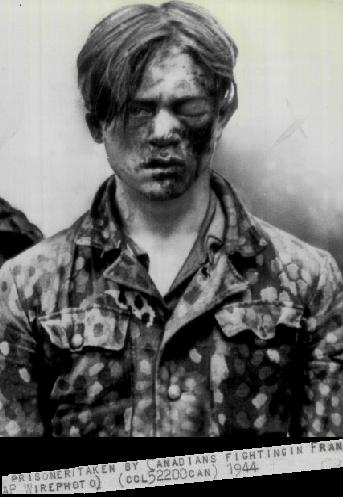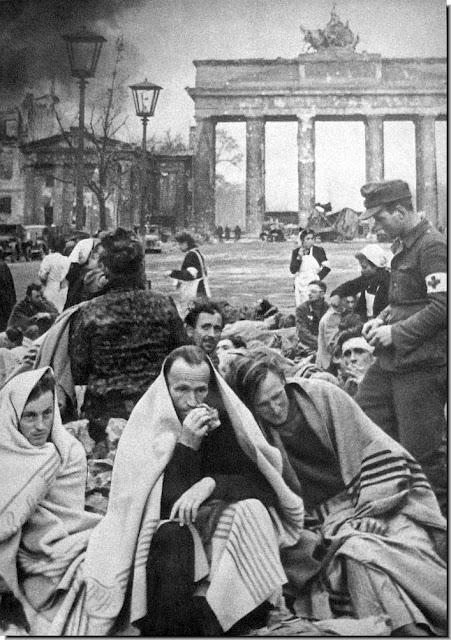In almost any war one side can be dishonestly demonized even by a truthful enumeration of its crimes, if the crimes of its adversaries are suppressed. —Irmin Vinson
Excerpted from Thomas Goodrich’s 2010 book
Hellstorm:
The Death of Nazi Germany
(1944-1947)
The Halls of Hell
Because their knowledge of the language and culture was superb, many of the intelligence officers accompanying US and British forces into the Reich were Jewish refugees who had fled Nazi persecution in the late 1930s.
In theory, “de-Nazification” was a simple transplanting of Nazi officials with those of democratic, socialist or communist underpinnings. In practice, the purge became little more than a cloak for an orgy of rape, torture and death.
One man opposed to the vengeance-minded program was George Patton. “Evidently the virus started by Morgenthau and Bernard Baruch of a Semitic revenge against all Germans is still working,” wrote the general in private. “I am frankly opposed to this war-criminal stuff. It is not cricket and it is Semitic… I can’t see how Americans can sink so low.”
♣
Horrific as de-Nazification was in the British, French and, especially, the American zones, it was nothing compared to what took place in Poland, behind the Soviet lines. In hundreds of concentration camps sponsored by an apparatus called the “Office of State Security,” thousands of Germans—male and female, old and young, high and low, Nazi and anti-Nazi, SS, Wehrmacht, Volkssturm, Hitler Youth, all—were rounded up and imprisoned. Staffed and run by Jews, with help from Poles, Czechs, Russians, and other concentration camp survivors, the prisons were little better than torture chambers where dying was a thing to be prolonged, not hastened. While those with blond hair, blue eyes and handsome features were first to go, anyone who spoke German would do.
After barely surviving his “interrogation,” one fourteen-year-old was taken to the camp infirmary. “My body was green, but my legs were fire red,” the boy said. “My wounds were bound with toilet paper, and I had to change the toilet paper every day. I was in the perfect place to watch what went on… All the patients were beaten people, and they died everywhere: at their beds, in the washroom, on the toilet. At night, I had to step over the dead as if that were normal to do.”
At the larger prison camps, Germans died by the hundreds daily.
“You pigs!” the commandant then cried, and he beat the Germans with their stools, often killing them. At dawn many days, a Jewish guard cried, “Eins! Zwei! Drei! Vier!”
The guard then cried, “Get undressed” and, when the Germans were naked, he beat them, poured liquid manure on them, or, catching a toad, shoved the fat thing down a German’s throat, the German soon dying.
Some Germans were forced to crawl on all fours and eat their own excrement as well as that of others. Many were drowned in open latrines. Hundreds were herded into buildings and burned to death or sealed in caskets and buried alive.
When a smattering of accounts began to leak from Poland of the unspeakable crimes being committed, many in the West were stunned. “One would expect that after the horrors in Nazi concentration camps, nothing like that could ever happen again,” muttered one US senator, who then reported on beatings, torture and “brains splashed on the ceiling.” Wrote author Freda Utley, who learned of the horror after speaking with American jurist Edward van Roden:
Van Roden said: “All but two of the Germans in the 139 cases we investigated had been kicked in the testicles beyond repair. This was standard operating procedure with our American investigators.”
When criticism such as Utley’s and van Roden’s surfaced, and even as victims were being hung by the hundreds, those responsible defended their methods. “We couldn’t have made those birds talk otherwise,” explained Colonel A.H. Rosenfed. “It was a trick, and it worked like a charm.”
Certainly no anti-Semite herself, as fervently anti-Nazi as she was anti-communist, journalist Freda Utley gave substance to the growing mood in her book, The High Cost of Vengeance: “It is the American Jews (often of Polish or Russian origin) and the returned exiles who seem determined to avenge the agony of the Jewish people in Hitler’s Reich by punishing the whole German people.”
♣
One year after war’s end, the former Reich was still a land of “troglodytes” with urban-dwellers clinging precariously to their caves and cracks. After viewing for himself conditions in Hamburg, Victor Gollancz was horrified. Penned the Jewish publisher to his wife in England:
She [a German survivor] looked fifty but I suspected she was about twenty-five. This was an extraordinary creature, with a huge nose, a bony, emaciated face, and several front teeth missing. She also appeared to be pretty crippled, and her hand was shaking terribly, I suppose of hunger.
On their own, orphans aged fast, and little girls aged fastest of all. Like their older sisters, the children soon discovered that selling themselves could stave off starvation.
In his Christmas Eve 1945 message, Pope Pius XII appealed to the world to end the “ill-conceived cruelty” that was secretly destroying the German people. As powerful as the Pope’s plea undoubtedly was, a report later filed by Herbert Hoover was perhaps more shocking and had greater implications. After visiting Germany, the former US president told of homeless children freezing to death by the hundreds.
Also sifting to the surface were horrific tales of Allied torture chambers. “AMERICANS TORTURE GERMANS TO EXTORT CONFESSIONS,” ran British headlines. “An ugly story of barbarous tortures inflicted in the name of allied justice… strong men were reduced to broken wrecks ready to mumble any admission demanded by their prosecutors.”
Embarrassed and aghast, many Americans were horror-stuck. Viewing Allied atrocities against Germany as a whole, it was, said Henrick Shipstead on the floor of the US Senate, “America’s eternal monument of shame, the Morgenthau Plan for the destruction of the German-speaking people.” Although Henry Morgenthau was gone—ousted by President Truman—and although some of the more savage aspects of the plan had been shelved, the agreement signed by the victorious Allies at Potsdam was in many aspects even more draconian than the original.
Even as the chorus of critics over the sadistic treatment of Germany grew, a nightmare of almost unbelievable proportions was developed behind the Iron Curtain.
____________________________
Educate yourself about the Holocaust perpetrated on the German people by the Allied forces that the mainstream media has covered up for nearly seventy years.
Hellstorm is still available from the publisher.



